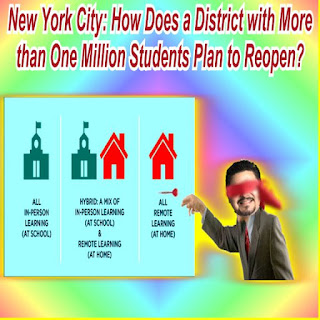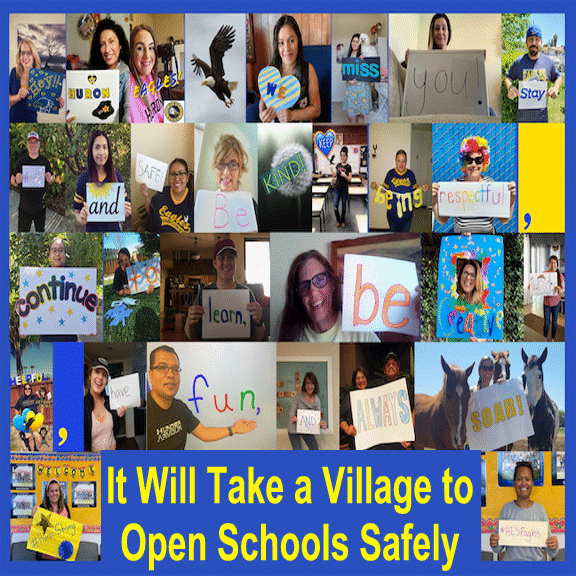Resources Identified to Support Distance Learning - Year 2020 (CA Dept of Education)
State Superintendent Tony Thurmond and Digital Divide Task Force Identify Resources, Partnerships Available to Support Successful Distance Learning in the Fall
SACRAMENTO—State Superintendent of Public Instruction Tony Thurmond and leaders serving on the Closing the Digital Divide Task Force identified new resources and partnerships today to support California schools preparing for distance learning this fall. The task force, co-chaired by Senator Connie Leyva (D-Chino), has been working since April to help equip all California students with computing devices and connectivity as schools prepare for the new academic year.
Among the resources identified Thursday include more than $5 billion available in the state budget to school districts to acquire devices, strengthen distance learning and address learning gaps. Task Force members also learned more about the progress of a multi-million dollar initiative spearheaded by Intel Corp. to support online learning.
“As the COVID-19 pandemic forces more school districts to resume virtual learning in the fall, this work grows increasingly urgent. But it is not insurmountable: Together, I believe we have the opportunity to rapidly build on the progress we already have made to date to close the digital divide,” Thurmond said. “Hundreds of thousands of students still lack the basic tools to connect to their learning. This is unacceptable, and now is the time to accelerate our efforts so that no student is left behind.”
The California Department of Education (CDE) estimates more than 700,000 students still lack computing devices and another 300,000 lack hotspots to connect to the internet. Subsequently, Thurmond has launched a campaign asking more than 100 of California’s top private industry partners, businesses, and donors to contribute to a $500 million initiative that would provide the technological resources to these students.
Senator Leyva agreed with Thurmond on the urgency of meeting this need. “As the vast majority of California students will start the upcoming school year learning remotely, it’s important that we strengthen distance learning and address the lack of access and connectivity for students across the state,” she said. “It is critical that we minimize learning loss and expand ongoing opportunities for the continued success and achievement of all students.”
Ben Chida, chief deputy cabinet secretary for Governor Gavin Newsom, provided an update on Learning Loss Mitigation Funds authorized by the 2020–21 state budget, which allocates $5.3 billion to local educational agencies to support transitional kindergarten through twelfth grade academic achievement, mitigate learning gaps exacerbated by COVID-19 school campus closures, and purchase computing and connectivity devices. School districts are now able to apply for these funds. Intel provided an additional example of ways the private sector can partner on solutions. During the task force hearing, Intel representatives Gregg Descheemaeker and Darrell Stewart presented an update on the Intel Pandemic Response Technology Initiative , which supports education-focused nonprofit organizations and business partners to provide students without access to technology with devices and online learning resources. By partnering with public school districts, the initiative will enable PC donations, online virtual resources, study-at-home guides, and device connectivity assistance.
, which supports education-focused nonprofit organizations and business partners to provide students without access to technology with devices and online learning resources. By partnering with public school districts, the initiative will enable PC donations, online virtual resources, study-at-home guides, and device connectivity assistance. State Superintendent Thurmond’s Digital Divide Task Force and CDE have played a key role in facilitating the shipment of more than 73,000 computing devices to hundreds of school districts statewide. These devices were provided by donations to the Bridging the Digital Divide Fund by philanthropy, companies, and individuals through the fund’s GoFundMe page. Among the recipients are more than 16,000 homeless students and another 2,000 students in the foster system.
Additionally, the task force has worked with districts and the California Public Utilities Commission to subsidize nearly 87,000 hotspots for students in 368 school districts. Additionally, to date, 100,000 hotspots have been delivered to more than 200 school districts across the state thanks to T-Mobile and Google donations.
After multiple task force hearings, Internet Service Providers (ISPs) are now also making meaningful commitments. ISPs have opened up their hotspots for public access and now have dedicated staff who can more quickly resolve problems with accessing low-income services. The task force and CDE have directly assisted ISPs in moving forward with internet infrastructure projects by connecting them to the new Broadband Coordinator at Caltrans. And with more barriers removed for low-income households, students in many parts of the state now have access to reduced-cost Wi-Fi where available.
An archived broadcast of today’s task force hearing and past hearings can be watched on the California Department of Education (CDE) Facebook page .
.
# # # #
Tony Thurmond — State Superintendent of Public Instruction
Communications Division, Room 5602, 916-319-0818, Fax 916-319-0100 Virtual Classroom Lesson on Asian American Studies
Year 2020 (CA Dept of Education) - https://www.cde.ca.gov/nr/ne/yr20/yr20rel60.asp
SACRAMENTO—Students who gathered for a virtual classroom lesson on Asian American Studies on Tuesday, hosted by State Superintendent of Public Instruction Tony Thurmond, learned about Fred Korematsu’s fight against imprisonment during World War II. Korematsu’s 40-year battle in the Supreme Court would in part lead to the Civil Liberties Act of 1988 which included a formal apology as well as reparations to Japanese Americans imprisoned during the war.
“Fred Korematsu’s story is one that should empower all of us stand up for ourselves and for what’s right, even if it takes years or decades for justice,” said Thurmond. “As our nation experiences an urgent movement for racial justice, we’ve heard from students from around the state speaking up that this work begins in the classroom. Today’s virtual classroom was an example of what that can look like.”
The virtual classroom session was hosted by Superintendent Thurmond and featured Dr. Karen Korematsu sharing her father’s personal story as well as her own. Guests included students from throughout California, Assemblymember David Chiu, and Professor Grace Yeh, Ph.D. of California Polytechnic State University at Cal Poly San Luis Obispo, who spoke about the importance of Asian American Studies and gave a brief history of Asians and Pacific Islander Americans. An archived broadcast can be found on the California Department of Education (CDE) Facebook page .
.
As the CDE prepares to submit a revised Ethnic Studies Model Curriculum for public review, this series will help students, educators, and families familiarize themselves with the core areas of ethnic studies, including how different groups have struggled and worked together, as well as key concepts such as equality, justice, race, ethnicity, and indigeneity.
During Tuesday’s webinar, Dr. Karen Korematsu shared her father’s story and overview of the Korematsu Institute, whose mission is to advance racial equity, social justice, and human rights for all. Since her father’s passing in 2005, Karen has carried
on his legacy as a public speaker, educator, and civil rights advocate. She shares her father’s passion for social justice and education and in 2009 established the Fred T. Korematsu Institute.
In a question-and-answer session, students and members from the Asian Pacific Youth Leadership Project and U.S. Senate Youth Program expressed their support for more Asian American and Pacific Islander history to be taught earlier, and in a more relatable, modern way. Students also drew inspiration from realizing the direct connection and intersection between the history and experiences of Asian Americans and Pacific Islanders and other indigenous and people of color in the United States. And before delivering closing remarks, State Superintendent Thurmond offered to provide reading materials on Asian Americans to the first 100 students who reach out to the CDE.
This series of virtual classroom sessions continues with one more event on July 28. Each session focuses on one of four foundational groups of ethnic studies: Africana Studies, Asian American Studies, Chicano Latino Studies, and Indigenous Studies. The series features prominent leaders and educators from each discipline to provide a lecture. All events in the series are broadcast on the CDE Facebook page . The remaining event is as follows:
. The remaining event is as follows:
- Tuesday, July 28, 2 p.m. to 3:30 p.m. Indigenous Studies with Assemblymember James C. Ramos, co-founder of the San Manuel Band of Mission Indians' Cultural Awareness Program and director of the California Indian Cultural Awareness Conference at California State University, San Bernardino.
# # # #
Tony Thurmond — State Superintendent of Public Instruction
https://www.cde.ca.gov/nr/ne/yr20/yr20rel60.asp
![]() .
.![]() . The remaining event is as follows:
. The remaining event is as follows:































